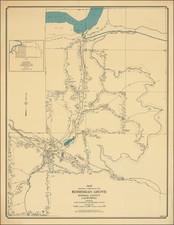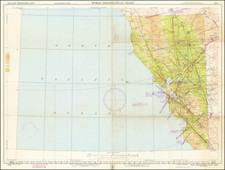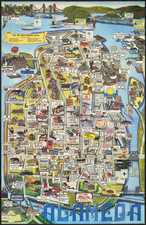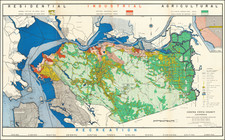Solnit's Preferred Late-Afternoon Variant
The Most Complete View of San Francisco Ever Made
Muybridge's Panorama of San Francisco - A Cinematic Precursor
An iconic photographic panorama of San Francisco by arguably the most technically gifted, historically significant photographer of 19th century California. This wonderful photographic object, here in a beautiful example, unfolds to seven-plus feet and fully embodies Muybridge's technical and aesthetic virtuosity. Muybridge's panorama is a superb visual record of the bustling 19th-century West Coast metropolis, and stands as a remarkable technical achievement, which required numerous complex calculations to correctly orient each exposure into a continuous image. Indeed, this panorama helped spawn the photographer's interest in progressive motion and sequential imaging, laying the groundwork for the great series of stop-motion photographs of people and animals in motion that Muybridge would produce later in his fascinating career. It should be remembered that Muybridge invented the zoopraxiscope, an important forerunner of the motion picture machine, and several scholars have argued that painted moving panoramas, a wildly popular entertainment in the early 19th century (and an obvious precursor to the photographic panorama) were important antecedents to the cinema.
Muybridge captured this panorama from the vantage point of the central tower of Mark Hopkins's unfinished Nob Hill home at the corner of California and Mason streets - some "381 feet above the ordinary high tide." This was when Nob Hill was still known as California Street Hill. The photographic work was made sometime between May 23 and July 3 (probably on a Monday, as people can be seen doing their wash), during a period of approximately five hours, as evidenced by the shifting shadows in the panorama. Muybridge began in late morning with the view towards the south-west (now plate 10 of the panorama) and moved in a clockwise direction (proceeding through plates 11 and 1-9), moving the camera away from the sun. By mid-afternoon, when he made his final view (plate 9), the sun had moved 90-degrees. The resulting sweeping view, from 381 feet and encompassing 50 miles in length and 15 miles in width, constituted the most complete view of the city that had ever been made.
Originally published by Morse's Gallery, the panorama was first announced on July 11, 1877 in the San Francisco Bulletin. Muybridge then issued a prospectus of his own in September 1877, offering the panorama either mounted and bound in an album, for $10.00, or unmounted for $8.00. He announced his photographic achievement in the fall of 1877 with the following words:
I have the pleasure of informing you that I have just published a photographic Panorama of San Francisco, the points of view being from the tower of the new residence of Mark Hopkins, Esq., about 400 feet above the waters of the Bay.
The day selected for its execution was remarkable for the clearness of the atmosphere; all the public buildings, hotels and banks, all the wharves, with very few exceptions, and nearly all the stores and private residences within a radius of six miles being clearly distinguishable, the whole forming a complete Panorama of the entire city, its picturesque suburbs and surrounding ranges of hills.
And indeed the panorama is absolutely striking in detail and scope, depicting a booming San Francisco comprising a quarter of a million residents. Spiraling cathedrals speckle the mostly man-made landscape of townhouses that are now inextricably associated with the city. Such minute details as signage and laundry hanging on the rooftops of buildings in the distance are clearly discernable. Dirt roads and construction are evident in many of the panels, showing the expansion of the city. Masted sailing ships in the distance record San Francisco's status as an important West Coast port. When seen in light of panoramas produced after the 1906 earthquake the losses to this bustling city's 19th-century built environment seem all the more catastrophic.
The Clock Reads 5:30 on St. Mary's Church
In the present example the clock of St. Mary's Church in the fifth panel reads almost 5:30. Rebecca Solnit has pointed out that only a few examples of the panorama incorporate this late afternoon image, as most show the clock reading 1:45 pm. In the present 5:30 version, "the shadows are deeper, and the tide has changed so that the ships in the harbor have shifted and one more has sailed in..."
Solnit has written extensively on the technical and aesthetic achievements of Muybridge's panoramic photography, focusing on how his panoramic work presages his proto-cinematic motion studies.
These city panoramas are his most complex investigation of the subject of time before the motion studies, in the way the individual images develop a sequence....
Such a view had rarely if ever been attempted photographically. It was seldom possible to get high enough in the center of a city to see in all directions at once, and until the 1870s virtually the whole city of San Francisco lay east of the promontory anyway... Too, the usual 180-degree view reconstructed what could be seen in a single glimpse... made sense to the eye. But Muybridge's Nob Hill panoramas are an impossible sight, a vision of the city in all directions, a transformation of a circular space into a linear photograph...
It is conceptually dizzying to realize that several hours of the day are on view at once, and that the hours are not necessarily in order. To look at the panorama is to look at time, not a moment of it but several moments separated by long intervals... which is to say, akin to the motion studies he was soon to make....Like a movie, the 1877 panorama was edited together out of many discontinuous pieces of time into a plausible but fictitious continuity.
Making the full-circle panorama was a spectacular technical feat. Careful calculations divided the horizon into equal segments... and much skill was employed to pivot the camera correctly. Muybridge must have had a temporary darkroom set up in the Hopkins mansion and assistants to help with preparation and development of the negatives...- Solnit, pages 155, 159-160.
The noted Americana collector Thomas W. Streeter early recognized the value of Muybridge's panorama as an important visual record of the city - even if the rare book market of his day failed to appreciate the prescient collector's connoisseurship of western visual material: Streeter's copy fetched only $150 at auction in 1968). Streeter called the panorama:
The only actual photographic record of San Francisco of that period in almost its entirety that we possess.
Rarity:
While well represented in institutional confines, fine examples of Muybridge's great panorama are getting increasingly difficult to find in the market. Such examples have greatly increased in value in recent years.
Thomas Streeter suggested the estimated number of copies produced to be from 50 to 100. The mid 20th century Chicago bookseller Wright Howes accorded the panorama a respectable "b" rating in his idiosyncratic hierarchy of rarity (i.e. "mildly rare"). It is interesting to note that the landmark John Howell-Books Catalogue 50 (1979), which focused on rare California items, only included the smaller format 1911 reissue of Muybridge's great panorama.
Muybridge also produced a larger mammoth plate panorama of San Francisco, re-photographing the view from California Street Hill about a year later. The mammoth plate panorama is virtually unobtainable as only nine examples are extant, mostly in institutional collections. The present smaller version, also quite rare, predates the mammoth plate panorama, and remains a key achievement in Muybridge's then still evolving photographic practice.











![Weber's Map of Santa Clara County, California [cover title]](https://storage.googleapis.com/raremaps/img/small/79620.jpg)



![(Lake Arrowhead Photographs) [Group of 4 Lake Arrowhead / Arlington Lodge Photos ]](https://storage.googleapis.com/raremaps/img/small/93199.jpg)
